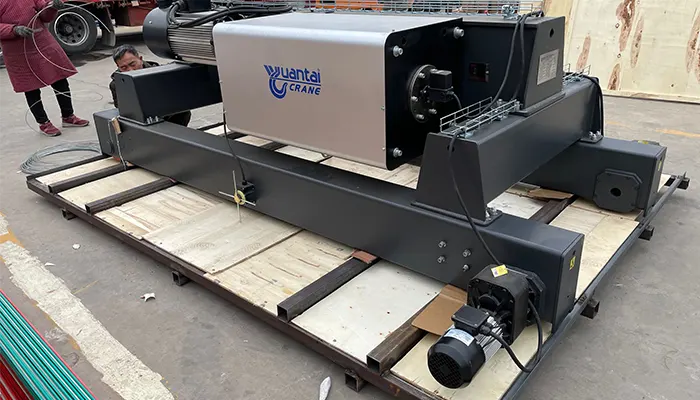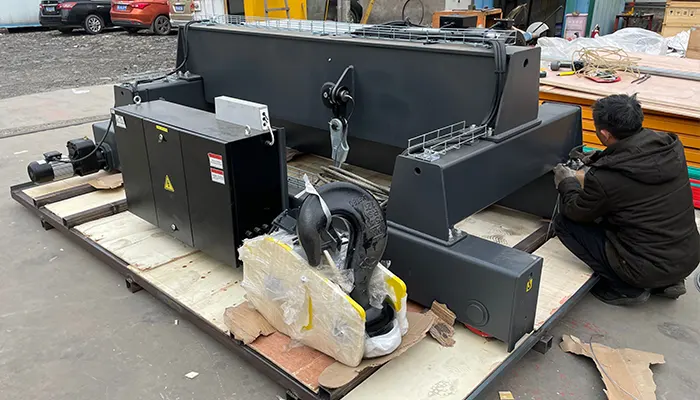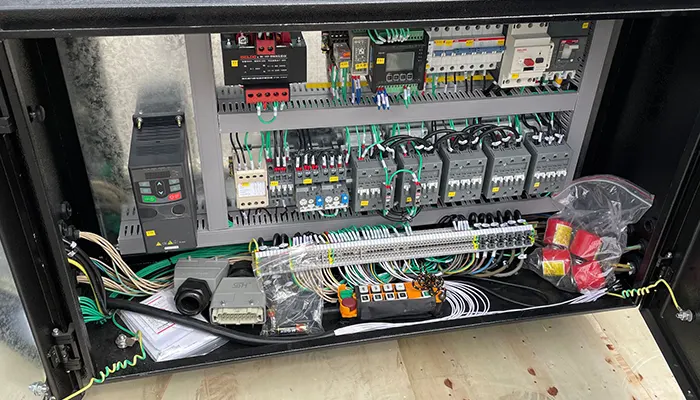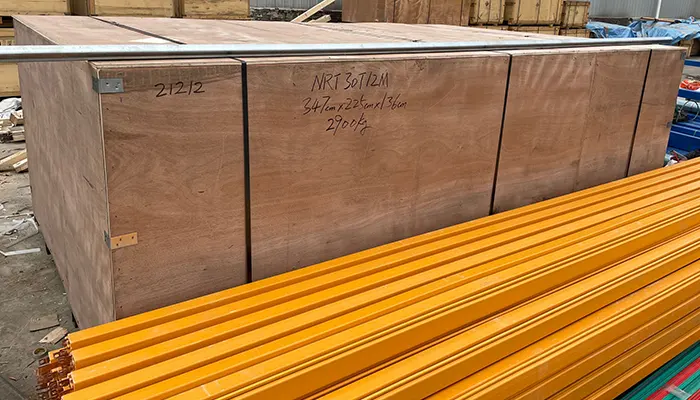30 T Electric Hoist Trolley for Argentina, Pre-Delivery Inspection
30 ton electric hoist for sale. What are pre-delivery checks to ensure reliability & safety of 30 ton electric hoist trolleyfor delivery in Argentina?
30 Ton Electric Hoist Trolley for Sale Argentina
The 30 Ton Electric Hoist Trolley is a state-of-the-art lifting device engineered for heavy-duty industrial applications. Designed to move and lift heavy loads with precision and reliability, this equipment is indispensable in various sectors, from construction to logistics. Its robust construction and advanced features make it ideal for environments where safety and efficiency are paramount.
30 ton wire rope electric hoist trolley for sale Argentina
Specifications:
Load Capacity: Capable of lifting loads up to 30 tons, ensuring it can handle the heaviest tasks.
Lifting Height: Can lift loads to a height of up to 50 meters, providing versatility for different operational needs.
Speed: Features variable lifting speeds to accommodate different load requirements and precision handling.
Power Supply: Typically operates on a 380V/50Hz power supply, but can be customized to meet regional electrical standards.
Motor: Equipped with a high-efficiency, heavy-duty motor that includes thermal protection to prevent overheating and ensure longevity.
Control System: Offers both remote control and manual control options, allowing operators to choose the most convenient and safe mode of operation.
Safety Features: Includes an emergency stop function, overload protection, and limit switches to enhance operational safety and prevent accidents.
Key Features:
High Load Capacity: Designed to handle up to 30 tons, making it suitable for the heaviest industrial tasks and ensuring robustness and reliability.
Precision Handling: The variable speed control enables precise lifting and positioning of heavy loads, enhancing operational efficiency and safety.
Robust Construction: Built with high-quality, durable materials to withstand harsh industrial environments, ensuring long-term reliability and reduced maintenance needs.
Advanced Safety Mechanisms: Equipped with essential safety features such as emergency stops, overload protection, and limit switches to ensure safe operation at all times.
User-Friendly Controls: Provides flexible control options, including remote and manual controls, allowing operators to manage the hoist trolley with ease and according to their preference.
Low Maintenance: Engineered for durability with minimal maintenance requirements, ensuring the hoist trolley remains operationally efficient over extended periods.
Intended Use and Applications:
The 30 Ton Electric Hoist Trolley is highly versatile and can be utilized across various industrial sectors. Here are some of its common applications:
Construction: Ideal for lifting and moving heavy construction materials such as steel beams, concrete slabs, and other large building components. Its high load capacity and precision handling make it indispensable on construction sites.
Manufacturing: Perfect for transporting large machinery parts, assembly line components, and heavy raw materials. It ensures efficient and safe handling of bulky items in manufacturing plants.
Logistics and Warehousing: Efficient in managing large and heavy cargo, containers, and pallets in warehouses and shipping docks. It streamlines operations and improves handling efficiency in logistics centers.
Mining: Suitable for lifting and transporting heavy mining equipment and extracted materials. It enhances operational efficiency and safety in mining operations.
Shipbuilding: Essential for lifting and positioning heavy ship components during construction and maintenance. Its robustness and precision handling are crucial in the shipbuilding industry.
In summary, the 30 Ton Electric Hoist Trolley is a critical tool for industries that require the handling of extremely heavy loads. Its robust design, advanced features, and comprehensive safety mechanisms make it a reliable and efficient choice for various heavy-duty applications. As we move forward in this blog, we will explore the meticulous inspection processes that ensure this equipment meets the highest standards before being delivered to Argentina.
Importance of Pre-Delivery Inspection
The pre-delivery inspection process is a crucial step in ensuring that the 30 Ton Electric Hoist Trolley meets the highest standards of safety, reliability, and customer satisfaction. Here’s why this process is essential:
Ensuring Safety and Reliability
Safety is paramount when dealing with heavy-duty industrial equipment. The 30 Ton Electric Hoist Trolley is designed to lift and transport massive loads, and any malfunction can lead to severe accidents and injuries. Pre-delivery inspections ensure that every component of the hoist trolley is in optimal working condition. This includes checking the structural integrity, verifying the load capacity, and ensuring that all safety mechanisms, such as emergency stops and overload protections, are functioning correctly.
Reliability is equally important. Businesses depend on this equipment for critical operations, and any downtime can lead to significant productivity losses. By conducting thorough inspections, manufacturers can identify and address any potential issues before the equipment is delivered, ensuring it operates smoothly and reliably once it reaches the customer.
Compliance with International Standards
International standards set the benchmark for safety, quality, and performance in industrial equipment. The 30 Ton Electric Hoist Trolley must comply with various standards, such as ISO (International Organization for Standardization) and regional safety regulations. Pre-delivery inspections involve rigorous testing and verification to ensure that the equipment meets these standards. This compliance is crucial not only for legal reasons but also for maintaining the credibility and reputation of the manufacturer.
By adhering to international standards, manufacturers ensure that their products are safe, reliable, and fit for purpose, regardless of where they are used. This compliance is particularly important for international shipments, like those to Argentina, where regulatory requirements may vary.
Enhancing Customer Satisfaction
Customer satisfaction is a key driver of business success. Ensuring that the 30 Ton Electric Hoist Trolley is delivered in perfect working condition is vital for meeting customer expectations. Pre-delivery inspections play a significant role in this by ensuring that the equipment is free from defects and ready for immediate use upon arrival.
These inspections also provide an opportunity to fine-tune the equipment according to the customer's specific needs and requirements. By delivering a product that meets or exceeds expectations, manufacturers can build trust and loyalty with their customers. Moreover, a well-inspected and reliable product reduces the likelihood of returns, repairs, and complaints, leading to higher customer satisfaction.
In summary, the pre-delivery inspection process is essential for ensuring the safety, reliability, and compliance of the 30 Ton Electric Hoist Trolley. It also plays a crucial role in enhancing customer satisfaction by delivering a high-quality, ready-to-use product. As we continue in this blog, we will explore the specific steps involved in the inspection process, providing a comprehensive understanding of how these inspections are conducted and their impact on the overall quality of the equipment.
Inspection Checklist Before Delivery
Ensuring that the 30 Ton Electric Hoist Trolley is safe, reliable, and compliant with international standards involves a comprehensive inspection checklist before delivery. This checklist covers various aspects of the hoist trolley to guarantee its optimal performance and safety. Here, we focus on the Mechanical Inspection.
Mechanical Inspection
A thorough mechanical inspection is the foundation of the pre-delivery inspection process. This step ensures that all physical components of the hoist trolley are in excellent condition and capable of performing as expected under heavy-duty conditions. The mechanical inspection includes the following key areas:
Structural Integrity
Frame and Body Inspection: The frame and body of the hoist trolley must be free from any cracks, dents, or deformities. Inspectors check for signs of fatigue or damage that could compromise the structural integrity of the equipment.
Weld Quality: All welds are examined to ensure they are strong and free from defects. Poor weld quality can lead to structural failures, especially under heavy loads.
Fasteners and Bolts: Inspectors verify that all fasteners and bolts are correctly tightened and in good condition. Loose or damaged fasteners can lead to mechanical failures and pose significant safety risks.
Load Capacity Verification
Load Testing: The hoist trolley undergoes load testing to confirm that it can safely lift and transport the specified maximum load of 30 tons. This involves lifting weights up to and sometimes exceeding the rated capacity to ensure the equipment can handle the maximum load without issues.
Safety Margins: Inspectors check that the equipment includes appropriate safety margins to handle occasional overloads without compromising safety or performance.
Component Wear and Tear Check
Gears and Bearings: Critical components like gears and bearings are inspected for signs of wear and tear. These parts must be in excellent condition to ensure smooth and efficient operation. Any worn or damaged components are replaced to prevent operational failures.
Wire Ropes and Chains: The wire ropes and chains used in the hoist mechanism are inspected for fraying, kinks, or any form of damage. These components are crucial for lifting heavy loads, and any compromise in their integrity can lead to catastrophic failures.
Brakes and Clutches: The braking and clutch systems are tested to ensure they are functioning correctly. Reliable brakes are essential for safe operation, particularly when lifting and holding heavy loads.
The mechanical inspection is a critical part of the pre-delivery checklist for the 30 Ton Electric Hoist Trolley. By thoroughly examining the structural integrity, verifying load capacity, and checking for component wear and tear, manufacturers ensure that the equipment is safe, reliable, and ready for heavy-duty industrial use. This meticulous inspection process helps prevent accidents, prolongs the lifespan of the hoist trolley, and enhances customer satisfaction by delivering a high-quality product. As we continue in this blog, we will explore additional aspects of the inspection process, including electrical inspections, operational testing, and quality assurance measures.
Ensuring Safety and Performance: Inspection Protocols for 30 Ton Electric Hoist Trolleys Shipped to Argentina
Electrical Inspection
The electrical inspection ensures that the hoist trolley's electrical systems are functioning correctly and safely. This involves a thorough examination of all electrical components, from the main power supply to the smallest wiring connections. The key areas of the electrical inspection include:
Electrical System Testing
Power Supply Verification: Inspectors verify that the hoist trolley is configured to operate with the correct power supply (typically 380V/50Hz, but customizable as needed). This ensures that the trolley will function properly in the intended operating environment.
Motor Performance: The performance of the heavy-duty motor is tested under various conditions to ensure it delivers the required power and efficiency. This includes checking for any unusual noises, vibrations, or overheating.
Control System Functionality: Both the remote control and manual control systems are tested to ensure they are responsive and reliable. This includes verifying that all control commands are accurately executed by the hoist trolley.
Safety Devices and Limit Switches
Emergency Stop Functionality: The emergency stop buttons are tested to ensure they can immediately halt the hoist trolley's operation in case of an emergency. This is a critical safety feature that must be reliable at all times.
Overload Protection: The hoist trolley is equipped with overload protection systems that prevent it from lifting loads exceeding its capacity. Inspectors test these systems to ensure they activate correctly when the load limit is reached.
Limit Switches: Limit switches are inspected and tested to ensure they effectively stop the hoist at predetermined points, preventing over-travel and potential damage. These switches are crucial for maintaining operational safety and protecting the equipment from mechanical stress.
Wiring and Connections
Wiring Integrity: All electrical wiring is inspected for proper insulation, secure connections, and absence of damage. Faulty wiring can lead to short circuits, electrical failures, or fire hazards.
Connection Security: Inspectors check that all electrical connections are tight and secure, ensuring there are no loose wires or connectors that could cause operational issues or safety risks.
Cable Management: Proper cable management is verified to ensure that all cables are neatly arranged and protected from physical damage. This reduces the risk of electrical faults and extends the lifespan of the wiring.
The electrical inspection is a vital part of the pre-delivery checklist for the 30 Ton Electric Hoist Trolley. By thoroughly testing the electrical system, safety devices, limit switches, and ensuring the integrity of wiring and connections, manufacturers guarantee that the equipment is electrically safe and reliable. This meticulous inspection process helps prevent electrical failures, enhances operational safety, and ensures that the hoist trolley meets the highest standards before being delivered to Argentina. In the next sections of this blog, we will explore additional aspects of the inspection process, including operational testing and quality assurance measures.
Operational Testing
Operational testing is essential to ensure that the hoist trolley performs as expected under real-world conditions. This phase verifies the functionality of all movement mechanisms, speed controls, and emergency features. The key areas of operational testing include:
Functional Testing of Hoist and Trolley Movements
Lifting and Lowering Operations: Inspectors conduct multiple tests to ensure the hoist can lift and lower loads smoothly and safely. This includes verifying that the hoist can handle its maximum rated load without any issues.
Trolley Travel: The trolley’s horizontal movement along the beam is tested to ensure it operates without obstruction or irregularities. This involves moving the trolley back and forth across its full range of motion.
Load Handling: The hoist’s ability to lift, hold, and lower loads without swinging or instability is verified. This ensures safe and precise load handling during operation.
Speed Control and Precision Handling
Variable Speed Testing: The hoist trolley is tested at various speeds to ensure that it can operate both quickly and slowly, depending on the requirements. This includes verifying that speed changes are smooth and controlled.
Precision Positioning: Inspectors check the hoist’s ability to position loads accurately. This involves lifting and lowering loads to specific heights and moving the trolley to precise locations.
Response Time: The responsiveness of the control system is tested to ensure that commands from the remote or manual controls are executed promptly and accurately.
Emergency Stop Functionality
Immediate Halt Testing: The emergency stop feature is tested by simulating emergency conditions. The hoist and trolley must come to an immediate halt when the emergency stop button is pressed.
System Reset: Inspectors verify that the system can be safely reset and resumed after an emergency stop. This involves ensuring that the hoist trolley does not automatically resume operations without a manual reset.
Reliability Under Load: The emergency stop function is tested while the hoist is handling various loads, including its maximum capacity, to ensure it operates reliably under all conditions.
Operational testing is a critical part of the pre-delivery inspection checklist for the 30 Ton Electric Hoist Trolley. By thoroughly testing the functional movements, speed control, precision handling, and emergency stop functionality, manufacturers ensure that the equipment performs reliably and safely in real-world scenarios. This comprehensive testing process helps prevent operational failures, enhances safety, and ensures that the hoist trolley meets the highest standards before being delivered to Argentina. In the next sections of this blog, we will explore additional aspects of the inspection process, including final quality assurance measures and documentation.
Quality Assurance
Quality assurance measures ensure that the 30 Ton Electric Hoist Trolley meets the highest standards of quality, reliability, and compliance. This phase involves a thorough review of documentation, certifications, and adherence to industry standards. The key areas of quality assurance include:
Compliance with ISO Standards
ISO 9001 Certification: The manufacturer's quality management system is evaluated to ensure compliance with ISO 9001 standards. This certification demonstrates the manufacturer's commitment to quality and continuous improvement.
ISO 14001 Certification: Environmental management practices are reviewed to ensure compliance with ISO 14001 standards. This certification reflects the manufacturer's efforts to minimize environmental impact throughout the production process.
ISO 45001 Certification: Occupational health and safety practices are assessed to ensure compliance with ISO 45001 standards. This certification demonstrates the manufacturer's commitment to providing a safe and healthy working environment for employees.
Manufacturer’s Quality Certifications
CE Certification: The hoist trolley is evaluated to ensure compliance with CE marking requirements, indicating conformity with health, safety, and environmental protection standards for products sold within the European Economic Area (EEA).
UL Certification: If intended for use in the United States, the hoist trolley may be evaluated for UL certification, ensuring compliance with safety standards established by Underwriters Laboratories.
Other Industry-Specific Certifications: Depending on the intended application of the hoist trolley, additional certifications may be required, such as ATEX certification for use in potentially explosive atmospheres or NEMA certification for electrical enclosures.
Documentation and Records Review
Technical Documentation: All technical documentation, including user manuals, operating instructions, and maintenance schedules, is reviewed to ensure completeness and accuracy. Clear and comprehensive documentation is essential for safe and efficient operation of the hoist trolley.
Quality Records: Inspection reports, test results, and quality control records are reviewed to ensure that all inspection activities have been properly documented and recorded. These records provide evidence of compliance with quality assurance procedures and regulatory requirements.
Quality assurance is a critical aspect of the pre-delivery inspection checklist for the 30 Ton Electric Hoist Trolley. By verifying compliance with ISO standards, reviewing manufacturer's quality certifications, and conducting a thorough review of documentation and records, manufacturers ensure that the equipment meets the highest standards of quality, reliability, and safety. This rigorous quality assurance process helps build confidence in the product's performance and ensures customer satisfaction upon delivery to Argentina. In the final section of this blog, we will summarize the key findings of the inspection process and emphasize the importance of these protocols in maintaining safety and performance standards.
Packaging and Shipping Inspection
Proper packaging and securing of the hoist trolley for shipping are essential to prevent damage during transit. This phase focuses on ensuring that the equipment is adequately protected and secured for safe transportation to Argentina. The key areas of the packaging and shipping inspection include:
Proper Packaging for Transport
Protective Packaging: The hoist trolley is securely packed using suitable materials to protect it from impacts, vibrations, and other hazards during transit. This may include foam padding, bubble wrap, or wooden crates to cushion and support the equipment.
Packaging Integrity: Inspectors verify that the packaging is intact and free from damage. Any signs of damage or wear are addressed to ensure that the hoist trolley remains adequately protected during shipping.
Securing the Trolley for Shipping
Secure Fastening: The hoist trolley is securely fastened to its transport platform or container to prevent shifting or movement during transit. This may involve using straps, bolts, or other securing mechanisms to immobilize the equipment.
Weight Distribution: Proper weight distribution is ensured to prevent overloading or imbalance that could affect the stability of the transport vehicle. Inspectors check that the weight of the hoist trolley is evenly distributed and within the load limits of the transport vehicle.
Addressing Environmental Factors
Moisture Protection: Measures are taken to protect the hoist trolley from moisture damage during shipping. This may include using moisture-resistant packaging materials, desiccants, or moisture barriers to prevent corrosion or electrical damage.
Temperature Control: If the hoist trolley is sensitive to temperature variations, temperature-controlled packaging or shipping containers may be used to maintain optimal operating conditions during transit. This helps prevent damage caused by extreme temperatures.
The packaging and shipping inspection is the final step in the pre-delivery inspection checklist for the 30 Ton Electric Hoist Trolley. By ensuring proper packaging for transport, securing the trolley for shipping, and addressing environmental factors such as moisture protection, manufacturers ensure that the equipment arrives in Argentina safely and in optimal condition. This meticulous inspection process helps prevent damage during transit and ensures that the hoist trolley maintains its safety and performance standards throughout the shipping process. With the completion of this inspection, manufacturers can confidently deliver the hoist trolley to customers in Argentina, knowing that it has undergone thorough scrutiny and is ready for use.
Inspection Report
The Inspection Report serves as a comprehensive record of the findings from the pre-delivery inspection process for the 30 Ton Electric Hoist Trolley. This report documents all aspects of the inspection, including detailed findings, action items for addressing any identified issues, and certification of inspection.
Detailed Report of Findings
The Inspection Report provides a detailed summary of all inspections conducted, including mechanical, electrical, operational, quality assurance, and packaging and shipping inspections.
Each section of the report outlines the specific areas that were inspected, the inspection procedures followed, and the results of the inspections.
Findings are documented with precision, including any deviations from expected standards, observations of wear or damage, and areas of concern that require further attention.
Action Items for Any Identified Issues
For any issues identified during the inspection process, the Inspection Report outlines specific action items to address these concerns.
Action items may include recommendations for repairs, replacements, adjustments, or additional testing to ensure that the hoist trolley meets the required standards.
Each action item is assigned a priority level, timeline for completion, and responsible party to ensure accountability and timely resolution.
Certification of Inspection
The Inspection Report concludes with a certification section, confirming that the pre-delivery inspection of the 30 Ton Electric Hoist Trolley has been completed in accordance with established protocols and standards.
The certification verifies that the hoist trolley has undergone thorough scrutiny and meets all safety, performance, and quality requirements.
A signature from the inspector or quality assurance manager, along with the date of inspection, provides official confirmation of the inspection's completion and compliance.
The Inspection Report serves as a vital document in the pre-delivery inspection process for the 30 Ton Electric Hoist Trolley. It provides a detailed record of all inspection activities, findings, action items, and certification, ensuring transparency, accountability, and compliance with established standards. By documenting the inspection process in this comprehensive report, manufacturers can demonstrate their commitment to delivering safe, reliable, and high-quality equipment to customers in Argentina.
Conclusion
In conclusion, the pre-delivery inspection protocols for the 30 Ton Electric Hoist Trolleys play a pivotal role in ensuring the safety, reliability, and quality of the equipment upon delivery to Argentina. Throughout the inspection process, various aspects of the hoist trolley are meticulously scrutinized to verify compliance with international standards, identify any issues or concerns, and take corrective actions as necessary.
Summary of Inspection Importance
The inspection process encompasses mechanical, electrical, operational, quality assurance, packaging, and shipping inspections, covering all critical aspects of the hoist trolley's performance and safety.
Each phase of the inspection is essential for verifying the integrity of the equipment, ensuring compliance with industry standards, and addressing any potential issues before delivery.
By conducting thorough inspections, manufacturers demonstrate their commitment to delivering high-quality, reliable equipment that meets the needs and expectations of customers in Argentina.
Assurance of Product Quality and Safety Upon Delivery
With the completion of the pre-delivery inspection process, customers can have confidence in the quality, reliability, and safety of the 30 Ton Electric Hoist Trolley upon delivery.
The inspection protocols provide assurance that the hoist trolley has undergone rigorous scrutiny and meets the highest standards of performance and safety.
By prioritizing quality and safety throughout the inspection process, manufacturers ensure customer satisfaction and build trust and confidence in their products.
In essence, the pre-delivery inspection protocols are instrumental in upholding the safety, reliability, and quality of the 30 Ton Electric Hoist Trolleys shipped to Argentina. By adhering to these rigorous inspection procedures, manufacturers demonstrate their commitment to delivering equipment that meets the highest standards and exceeds customer expectations. This commitment to excellence ensures the continued success and reliability of the hoist trolley in diverse industrial applications.




